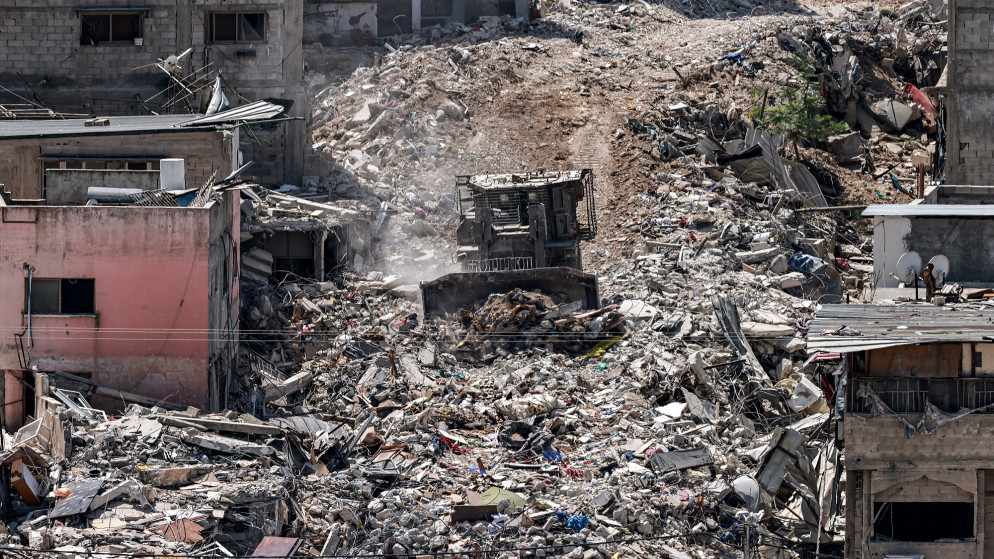Tulkarm – SABA:
Israeli bulldozers continued large-scale demolition operations today, Tuesday, targeting residential buildings in Nur Shams refugee camp, east of the city of Tulkarm in occupied Palestine. This marks the 149th consecutive day of aggression against the city and its camp, and the 136th day specifically targeting the camp.
According to the official Palestinian news agency, the demolitions focused on the al-Manshiya neighborhood and extended to the clinic, mosque neighborhoods, and the main street, with bulldozers leveling entire buildings and opening wide roads in their place—revealing the deliberate and systematic destruction by Israeli forces.
Nihad al-Shawish, head of the Popular Committee for Services in Nur Shams Camp, stated that Israeli forces continue to impose a tight siege on the camp, blocking citizens from entering while carrying out widespread destruction of homes, commercial establishments, and infrastructure. He described the situation as “organized criminality,” which has resulted in the destruction of around 400 housing units and the complete burning of about 20 homes, leaving the camp almost uninhabitable.
Al-Shawish accused the Israeli occupation of deliberately turning the camp into an unlivable zone, aiming to displace its residents permanently. He called on the international community to take action and support the residents facing this systematic eradication under international silence. He also urged international and human rights organizations to fulfill their responsibilities and act swiftly to stop the aggression and ensure justice for the displaced residents.
Over the past two weeks, more than 50 buildings have been demolished in Tulkarm camp alone, with wide roads carved through the heart of the camp, severely damaging infrastructure and residential areas in neighborhoods like al-Balawneh, al-‘Ukasha, al-Nadi, al-Sawalma, al-Hamam, and the schools’ area.
This escalation follows an Israeli plan announced in May to demolish 106 buildings across both camps—58 in Tulkarm camp alone, containing over 250 housing units and dozens of commercial establishments, and 48 in Nur Shams camp—under the pretext of opening roads and altering the geographical layout. The plan coincides with a strict siege, blocking residents from reaching their homes, and using live fire to deter anyone approaching the area.
Meanwhile, the city of Tulkarm and its suburbs, especially the eastern suburb of Dhannaba, have seen ongoing Israeli military movements. Occupation forces deliberately obstruct citizen movement, particularly in the marketplace, using vehicle sirens provocatively and driving against traffic, endangering civilians.
Israeli forces have also turned Nablus Street into a military zone, occupying several residential buildings and parts of the northern neighborhood of the city—opposite Tulkarm camp—after forcibly evacuating residents. Some of these buildings have been under Israeli control for over four months, with military vehicles and bulldozers heavily deployed.
Nablus Street, a key link between Tulkarm and Nur Shams camps, has been heavily damaged by soil barriers set up months ago. Random checkpoints and heavy military presence continue to hinder movement and exacerbate civilian suffering.
Israeli forces also arrested young man Omar Awda after raiding his home in the southern part of the city, and another young man, Iyad Al-Sayyes, after stopping his vehicle near Nur Shams camp and physically assaulting him.
To date, the ongoing aggression has led to the killing of 13 citizens, including a child and two women—one of whom was eight months pregnant—alongside dozens of injuries and arrests. The destruction has affected homes, infrastructure, commercial shops, and vehicles.
The escalation has also resulted in the displacement of over 5,000 families—more than 25,000 people—and the total destruction of more than 400 homes, with another 2,573 partially damaged. The entrances to the camps remain closed by earth mounds, turning them into near-ghost zones devoid of life.

| more of (International) |




